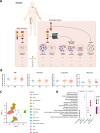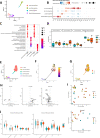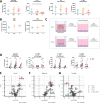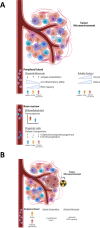Reprogramming of myeloid cells and their progenitors in patients with non-medullary thyroid carcinoma
- PMID: 36257966
- PMCID: PMC9579179
- DOI: 10.1038/s41467-022-33907-4
Reprogramming of myeloid cells and their progenitors in patients with non-medullary thyroid carcinoma
Abstract
Myeloid cells, crucial players in antitumoral defense, are affected by tumor-derived factors and treatment. The role of myeloid cells and their progenitors prior to tumor infiltration is poorly understood. Here we show single-cell transcriptomics and functional analyses of the myeloid cell lineage in patients with non-medullary thyroid carcinoma (TC) and multinodular goiter, before and after treatment with radioactive iodine compared to healthy controls. Integrative data analysis indicates that monocytes of TC patients have transcriptional upregulation of antigen presentation, reduced cytokine production capacity, and overproduction of reactive oxygen species. Interestingly, these cancer-related pathological changes are partially removed upon treatment. In bone marrow, TC patients tend to shift from myelopoiesis towards lymphopoiesis, reflected in transcriptional differences. Taken together, distinct transcriptional and functional changes in myeloid cells arise before their infiltration of the tumor and are already initiated in bone marrow, which suggests an active role in forming the tumor immune microenvironment.
© 2022. The Author(s).
Conflict of interest statement
The authors declare no competing interests.
Figures





Similar articles
-
Promotion of Expansion and Differentiation of Hematopoietic Stem Cells by Interleukin-27 into Myeloid Progenitors to Control Infection in Emergency Myelopoiesis.PLoS Pathog. 2016 Mar 18;12(3):e1005507. doi: 10.1371/journal.ppat.1005507. eCollection 2016 Mar. PLoS Pathog. 2016. PMID: 26991425 Free PMC article.
-
Generation of Myeloid Cells in Cancer: The Spleen Matters.Front Immunol. 2020 Jun 5;11:1126. doi: 10.3389/fimmu.2020.01126. eCollection 2020. Front Immunol. 2020. PMID: 32582203 Free PMC article. Review.
-
Bone Marrow Plasma Cells Modulate Local Myeloid-Lineage Differentiation via IL-10.Front Immunol. 2019 May 31;10:1183. doi: 10.3389/fimmu.2019.01183. eCollection 2019. Front Immunol. 2019. PMID: 31214168 Free PMC article.
-
CCR1 and CCR5 mediate cancer-induced myelopoiesis and differentiation of myeloid cells in the tumor.J Immunother Cancer. 2022 Jan;10(1):e003131. doi: 10.1136/jitc-2021-003131. J Immunother Cancer. 2022. PMID: 35064009 Free PMC article.
-
Implications of metabolism-driven myeloid dysfunctions in cancer therapy.Cell Mol Immunol. 2021 Apr;18(4):829-841. doi: 10.1038/s41423-020-00556-w. Epub 2020 Oct 19. Cell Mol Immunol. 2021. PMID: 33077904 Free PMC article. Review.
Cited by
-
Thyroid Cancer-The Tumor Immune Microenvironment (TIME) over Time and Space.Cancers (Basel). 2025 Feb 26;17(5):794. doi: 10.3390/cancers17050794. Cancers (Basel). 2025. PMID: 40075642 Free PMC article. Review.
-
A Comparative Analysis of NOX4 Protein Expression in Malignant and Non-Malignant Thyroid Tumors.Curr Issues Mol Biol. 2023 Jul 13;45(7):5811-5823. doi: 10.3390/cimb45070367. Curr Issues Mol Biol. 2023. PMID: 37504283 Free PMC article.
-
Polymersomes with splenic avidity target red pulp myeloid cells for cancer immunotherapy.Nat Nanotechnol. 2024 Nov;19(11):1735-1744. doi: 10.1038/s41565-024-01727-w. Epub 2024 Jul 31. Nat Nanotechnol. 2024. PMID: 39085390 Free PMC article.
-
Hematologic dysfunction in cancer: Mechanisms, effects on antitumor immunity, and roles in disease progression.Front Immunol. 2022 Dec 6;13:1041010. doi: 10.3389/fimmu.2022.1041010. eCollection 2022. Front Immunol. 2022. PMID: 36561751 Free PMC article. Review.
-
Efficacy and safety of immune checkpoint inhibitors for advanced non-small cell lung cancer with leptomeningeal metastases harboring targetable mutations.Transl Lung Cancer Res. 2024 Jul 30;13(7):1695-1707. doi: 10.21037/tlcr-24-477. Epub 2024 Jul 18. Transl Lung Cancer Res. 2024. PMID: 39118876 Free PMC article.
References
Publication types
MeSH terms
Substances
LinkOut - more resources
Full Text Sources
Medical

